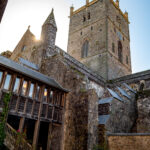 We’d been in Germany for a year when COVID hit, forcing us into lockdown. Our upcoming trip to Wales was canceled, and we spent the following year forced to stay at home. That ruling was particularly strict in Bavaria, but we found ways to make the most of it. One of the five things we could do was take care of animals, so Widgit, our Corgi/Border Collie mix, went on a LOT of walks. A few months in, Amberg, the nearest town, worked out a way to do contact-free takeaways.
We’d been in Germany for a year when COVID hit, forcing us into lockdown. Our upcoming trip to Wales was canceled, and we spent the following year forced to stay at home. That ruling was particularly strict in Bavaria, but we found ways to make the most of it. One of the five things we could do was take care of animals, so Widgit, our Corgi/Border Collie mix, went on a LOT of walks. A few months in, Amberg, the nearest town, worked out a way to do contact-free takeaways.
Our dining room was tucked away at the back of the house, but during this time, Dave and I turned it into a private restaurant. Dubbed The Back Room, we searched for little-known holidays to “go out” to dinner. One of these was St. David’s Day, which is celebrated on March 1st.
Americans have heard of St Patrick, the patron saint of Ireland. But how many know of the patron saints of the other countries in the British Isles? Saint George (England) celebrates his day on April 23rd. St. Andrew (Scotland) is honored on November 30th. Lesser saints, such as Saint Piran (Cornwall), Saint Brigid (Ireland), and Saint Columba (Scotland), also play significant roles in the history and culture of their countries. It is worth mentioning that St. Patrick is also the patron saint of Northern Ireland.
So, who is St. David? Today, he is known as the patron saint of Wales. He was born Dewi Sant in the 6th century in the region of Pembrokeshire, most probably around the year 500. His father was Sant, a prince of Cardigan, and his mother was St. Non, daughter of a local chieftain. In his youth, he was educated at the monastery of Hen Fynyw under the instruction of St. Paulinus. After completing his education, he traveled widely, spreading the Word, including a pilgrimage to Jerusalem, where he was ordained a bishop.
 Upon his return, he established several monasteries, including the famous Glyn Rhosyn (Vale of the Roses) in Pembrokeshire. Throughout his life, he preached humility and dedication to the Christian faith. He practiced asceticism or the strict practice of denying physical desires with the goal of attaining the spiritual ideal.
Upon his return, he established several monasteries, including the famous Glyn Rhosyn (Vale of the Roses) in Pembrokeshire. Throughout his life, he preached humility and dedication to the Christian faith. He practiced asceticism or the strict practice of denying physical desires with the goal of attaining the spiritual ideal.
Several miracles are attributed to Saint David, such as:
- Raising the ground beneath while speaking to a large gathering so that everyone could see and hear clearly
- Several stories exist of him restoring sight to the blind through prayer, including a man named Llywarch, whose sight was restored.
- He is credited with numerous instances of healing, including the story of his encounter with a Leper. Despite the man’s smell and appearance, Bishop David greeted him with an embrace, and the man was cured.
- There are reports that David also turned water into wine at a banquet where they ran out of wine, as Jesus did.

Bishop David died on March 1st, circa 589, and is buried at St. David’s Cathedral. His last words translate to, “Be joyful, and keep your faith and creed. Do the little things that you have seen me do and heard about. I will walk the path that our fathers have trod before us.”
David was recognized as a saint in the 12th century, and his feast day is March 1st. It is a significant day in Welsh culture and is celebrated each year throughout the country. While the Irish have their shamrock, the Welsh wear daffodils and leeks on his day. Both are symbols of Wales, and the military wears the emblem of a leek as a symbol of Welsh identity. Daffodils are more commonly seen pinned to clothing or as part of a bouquet.
Parades, concerts, poetry readings, and theatrical performances are held throughout the country. Tall black hats and red woolen shawls are the traditional dress, with a daffodil, of course. Eisteddfod is a competition involving music, literature, poetry, and theatrical performances.
Schools focus on their heritage, language, history, and culture. It is a day filled with national heritage, pride, and a sense of community spirit.
Traditional foods include:
- Welsh rarebit: a delicious combination of thick slices of bread and melted cheese mixed with mustard, beer, and Worcestershire sauce
- Cawt: a Welsh soup containing beef or lamb, leeks, carrots, potatoes, and rutabagas. Seasonal vegetables can be added.
- Bara Brith: a traditional fruit loaf containing tea-soaked dried fruits such as raisins, currants, and candied peel

- Picau Ar Y Maen: a griddle cake or flat scone containing dried fruit that is cooked on a griddle and dusted with sugar
- Lavarbread: a delicacy made from edible seaweed cooked into a thick, dark green paste. It is often mixed with oatmeal.
- Savory pies: filled with various meats and vegetables
- Glamorgan Sausages: a vegetarian sausage made with cheese, leeks, herbs, and breadcrumbs
- Teisen Lap: a cake resembling a flapjack flavored with lemon zest
 We enjoyed celebrating these other holidays so much that even after COVID lockdowns were over; we kept up the tradition of dining at The Back Room. Now, in our Maryland house, the dining room is in the middle, so maybe we will dine tonight at the Central Café. For St. David’s Day, I will be attempting Merthyr pie. This dish consists of beef, carrots, onions, celery, and seasonings layered with slices of sourdough bread and sharp cheese baked in the oven. I’ll let you know how it comes out.
We enjoyed celebrating these other holidays so much that even after COVID lockdowns were over; we kept up the tradition of dining at The Back Room. Now, in our Maryland house, the dining room is in the middle, so maybe we will dine tonight at the Central Café. For St. David’s Day, I will be attempting Merthyr pie. This dish consists of beef, carrots, onions, celery, and seasonings layered with slices of sourdough bread and sharp cheese baked in the oven. I’ll let you know how it comes out.

As always another great article. Always informitive and interesting. Can’t wait for dinner.
Thanks! I hope it turns out well. 🙂